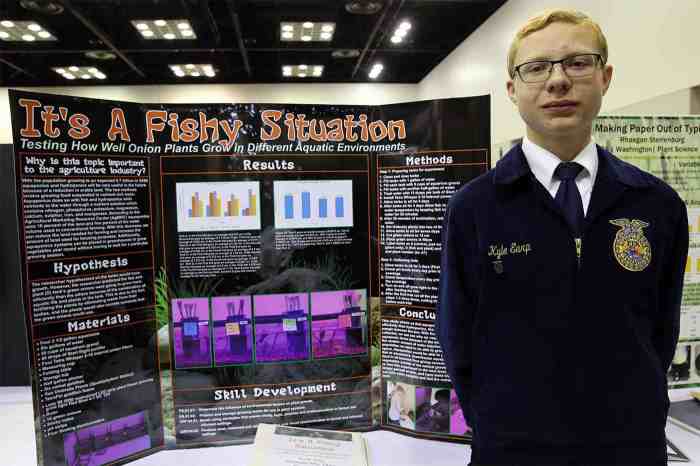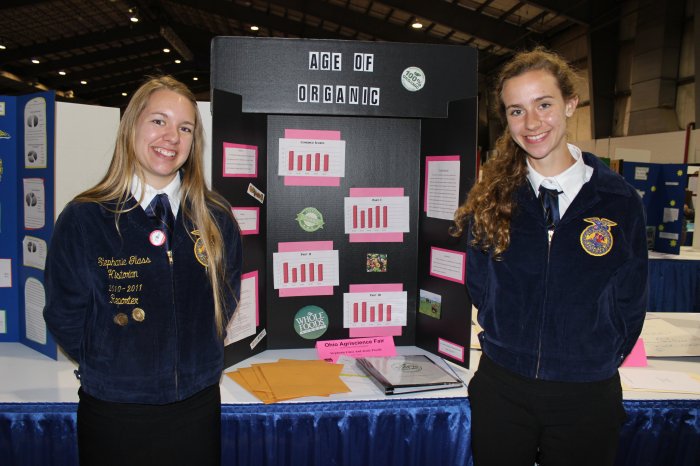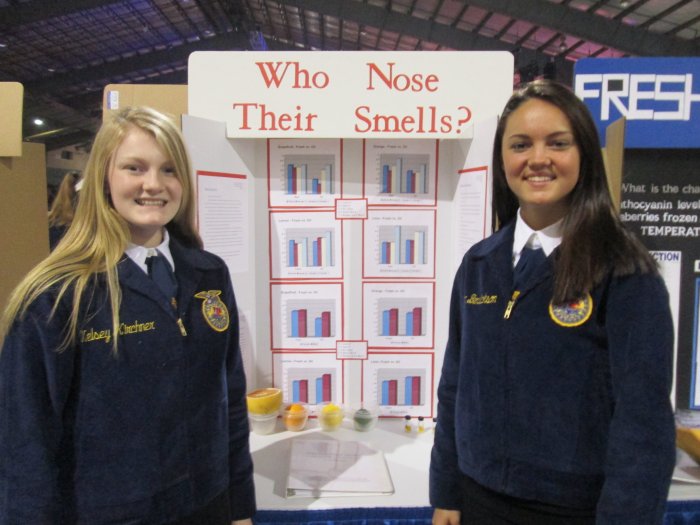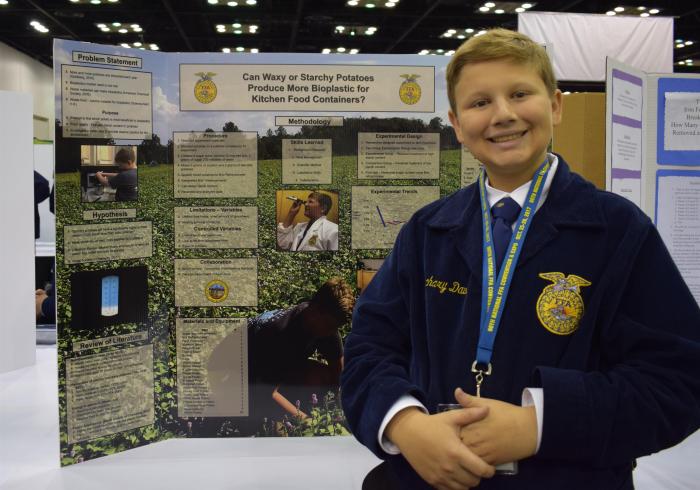What is the agriscience fair – Welcome to the captivating realm of the agriscience fair, where curiosity, innovation, and the pursuit of agricultural knowledge converge. As we embark on this journey, we’ll uncover the essence of these extraordinary events and delve into the transformative experiences they offer.
Agriscience fairs ignite a passion for agricultural education and research, providing a platform for young minds to showcase their ingenuity and dedication to the field. These events foster critical thinking, problem-solving skills, and a deep appreciation for the interconnectedness of science, agriculture, and our natural world.
Definition and Purpose of the Agriscience Fair
An agriscience fair is a platform for students to showcase their research and projects related to agriculture, food science, and natural resources. It provides a venue for them to demonstrate their understanding of agricultural concepts and their ability to apply scientific methods to solve real-world problems.
The primary objective of an agriscience fair is to promote agricultural education and research among students. It encourages them to explore various aspects of agriculture, develop critical thinking skills, and cultivate a passion for the field. The fair also provides an opportunity for students to connect with industry professionals, learn about career pathways in agriculture, and gain recognition for their achievements.
Role in Promoting Agricultural Education, What is the agriscience fair
Agriscience fairs play a vital role in promoting agricultural education by:
- Exposing students to a wide range of agricultural topics, from plant science and animal science to environmental science and food technology.
- Providing hands-on learning experiences that allow students to apply classroom knowledge to practical projects.
- Encouraging students to conduct research and develop problem-solving skills.
- Fostering collaboration among students, teachers, and industry professionals.
Role in Promoting Agricultural Research
Agriscience fairs also contribute to agricultural research by:
- Providing a platform for students to share their research findings with the scientific community.
- Encouraging students to pursue careers in agricultural research.
- Identifying promising research projects that can be further developed and supported.
Categories and Projects: What Is The Agriscience Fair

Agriscience fairs typically encompass a diverse range of categories, each catering to specific areas of agricultural science and technology. Projects within these categories showcase students’ research, experimentation, and innovative ideas.
The agriscience fair is a competition where students showcase their research projects in the field of agriculture. It’s a great way to gain hands-on experience and learn about the latest advancements in the industry. If you’re interested in pursuing a career in agriculture, you may want to consider taking a wset level 3 practice test to prepare for the exam.
The agriscience fair is also a great way to network with other students and professionals in the field.
The selection and evaluation of projects are based on predefined criteria, which may vary depending on the specific fair. However, common evaluation factors include scientific rigor, originality, presentation, and practical applications.
Animal Science
- Animal nutrition and feeding trials
- Animal breeding and genetics
- Animal health and disease management
Plant Science
- Plant growth and development studies
- Crop production and management
- Plant biotechnology and genetic engineering
Environmental Science
- Soil conservation and management
- Water quality and pollution monitoring
- Sustainable agriculture practices
Agricultural Technology
- Precision agriculture and data analysis
- Robotics and automation in agriculture
- Renewable energy and sustainable farming
Research and Experimentation

Scientific research is the cornerstone of agriscience projects, enabling students to explore complex agricultural issues and develop innovative solutions. By conducting thorough research, students can gain a deeper understanding of the subject matter and identify areas where they can make meaningful contributions.Research
begins with the formulation of research questions and hypotheses. Research questions should be specific, measurable, achievable, relevant, and time-bound (SMART). Hypotheses, on the other hand, are tentative explanations or predictions that can be tested through experimentation.Once the research question and hypothesis have been established, students can design their experiments.
Experimental design involves determining the variables to be tested, the methods to be used, and the controls to be implemented. Data collection and analysis are also crucial steps in the research process. Students should collect data accurately and analyze it using appropriate statistical methods to draw meaningful conclusions.
Importance of Research in Agriscience Projects
- Research helps students develop critical thinking and problem-solving skills.
- It fosters a deeper understanding of agricultural concepts and principles.
- Research projects allow students to apply their knowledge and skills to real-world problems.
- They contribute to the advancement of agricultural science and technology.
Presentation and Communication

Effective presentation skills are paramount in conveying the results of your agriscience project. A well-organized and engaging presentation will help the judges understand your research and appreciate its significance.
Organizing a Clear and Concise Presentation
- Structure your presentation logically:Begin with an introduction that provides an overview of your project, followed by sections that detail your research, methods, results, and discussion.
- Use clear and concise language:Avoid technical jargon and ensure your presentation is accessible to all audience members.
- Rehearse your presentation thoroughly:Practice your delivery to ensure you are comfortable and confident.
Visual Aids
Visual aids, such as posters and displays, can enhance your presentation and make it more engaging. Consider using:
- Posters:Create visually appealing posters that summarize your project and present your findings in a clear and concise manner.
- Displays:Use displays to showcase your research materials, such as equipment, samples, or data.
- Multimedia:Incorporate multimedia elements, such as videos or animations, to further illustrate your findings.
Judging and Awards

The judging process at agriscience fairs is designed to evaluate the quality and rigor of student projects. Projects are judged by a panel of experts who have experience in the field of agriculture, science, and education.
The judging criteria typically include:
- Project design and methodology
- Scientific accuracy and validity
- Originality and creativity
- Presentation and communication skills
- Overall impact and potential applications
Types of Awards
Agriscience fairs typically award students with a variety of awards and recognition. These may include:
- Grand prizes for the top overall projects
- Category awards for projects in specific areas, such as plant science, animal science, or environmental science
- Special awards for projects that demonstrate exceptional creativity, innovation, or impact
- Scholarships and other financial support to help students continue their education in agriculture or related fields
Benefits and Impact
Participating in agriscience fairs provides numerous educational benefits for students. These fairs offer a platform for students to develop their critical thinking, problem-solving, and communication skills. By conducting research and experimentation, students gain a deeper understanding of scientific concepts and the agricultural industry.
The process of preparing and presenting their projects fosters their confidence and presentation abilities.
Impact on Career Paths and Future Endeavors
Agriscience fairs play a significant role in shaping students’ career paths and future endeavors. The experiences gained through these fairs can spark students’ interest in pursuing careers in agriculture, science, and related fields. By showcasing their projects, students can connect with potential employers, mentors, and educational institutions.
Additionally, the awards and recognition received at agriscience fairs can provide students with a competitive edge in college admissions and scholarship applications.
Case Studies and Success Stories

The Agriscience Fair has witnessed numerous remarkable success stories, showcasing the exceptional talents and dedication of students. These projects have not only garnered awards and recognition but have also had a tangible impact on the field of agriculture and beyond.
Students have delved into cutting-edge research, developing innovative solutions to address real-world challenges in agriculture. Their projects have ranged from developing sustainable farming practices to harnessing technology for precision agriculture.
Inspiring Accomplishments
- One student developed a novel method for detecting crop diseases using artificial intelligence, significantly improving early diagnosis and treatment.
- Another student designed a system for monitoring soil moisture levels in real-time, enabling farmers to optimize irrigation and conserve water.
- A team of students created a mobile app that connects farmers with consumers, providing a platform for direct sales and reducing the carbon footprint of food distribution.
Long-Term Impact
The Agriscience Fair has not only fostered a love of agriculture in students but has also laid the foundation for their future careers. Many participants have gone on to pursue higher education in agricultural sciences, becoming leaders in the field.
The projects showcased at the fair have also had a broader impact on the agricultural industry. Some have been adopted by farmers, leading to improved productivity and sustainability. Others have inspired further research and innovation, contributing to the advancement of agricultural practices.
Resources and Support

The Agriscience Fair is supported by a wide range of resources and organizations that provide guidance and assistance to students and educators. These resources include:
Websites and Online Resources
- National FFA Organization: https://www.ffa.org/
- National Association of Agricultural Educators: https://www.naae.org/
- National Science Teachers Association: https://www.nsta.org/
- Agriculture in the Classroom: https://www.agclassroom.org/
Organizations and Programs
- 4-H Youth Development Program: https://4-h.org/
- Future Farmers of America (FFA): https://www.ffa.org/
- National Junior Angus Association: https://www.angus.org/
- National Junior Beef Association: https://www.jrbeef.org/
Individuals and Mentors
- Agricultural educators
- Scientists and researchers
- Extension agents
- Industry professionals
Quick FAQs
What is the purpose of an agriscience fair?
Agriscience fairs aim to promote agricultural education and research, providing a platform for students to showcase their projects and engage in scientific inquiry related to agriculture and its various disciplines.
What are some common categories featured in agriscience fairs?
Categories may include animal science, plant science, environmental science, food science, and agricultural mechanics, among others.
What is the role of research in agriscience projects?
Research is a fundamental aspect of agriscience projects, as it allows students to formulate hypotheses, design experiments, collect and analyze data, and draw conclusions based on their findings.

